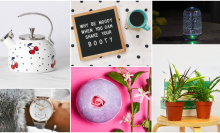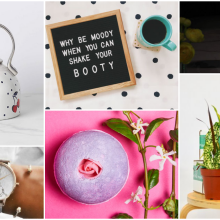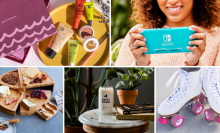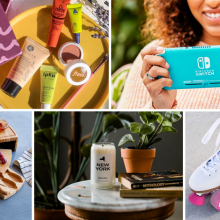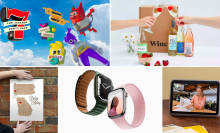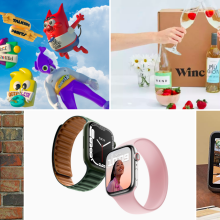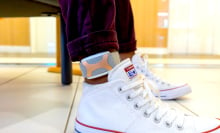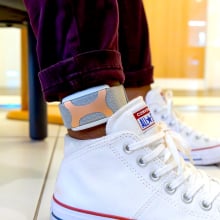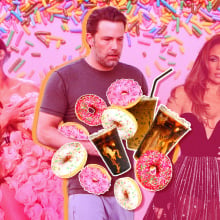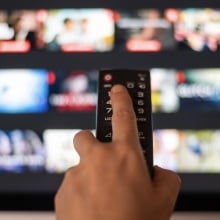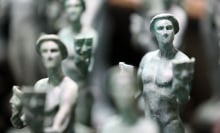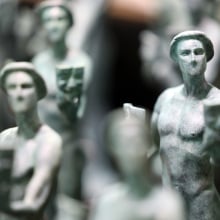Beauty trends on TikTok are a revolving door.
Last year's entries included: the clean girl aesthetic, strawberry girl, rat girl, latte makeup, and more. The app's latest favorite phenomenon is something called "visual weight." It's a dedicated filter that slices your face in two, applying heavier makeup on the left and lighter, more natural makeup on the right. But visual weight is much more complicated than simply applying makeup and, when done correctly, it can help you understand and celebrate your most unique features.
We dug into the trend's origins to understand its roots in East Asian beauty and its universal appeal.
What is visual weight?
Visual weight is a beauty theory that helps you to identify your face's unique features and amplify them with complementary styling. Its goal is to enhance your natural features, not alter them, and there is no such thing as "good" or "bad" visual weight. Instead, the theory proposes that all faces fall on a spectrum between "high" and "low" visual weights.
Faces with low visual weight look best in makeup that creates balance and harmony among their features, while folks with high visual weight shine in makeup styles highlight their largest or most prominent features.
Where did the term 'visual weight' come from?
The term "visual weight" has been popularized in the West by beauty creator "Dear Peachie" who mentioned the term in multiple YouTube videos on her channel before making a video about the concept in Jan. 2023. Dear Peachie's content aggregates beauty tricks from East Asia specifically, and fellow beauty creator Style Me Jenn says that focus may be key to understanding the "visual weight" trend.
In a video analyzing a visual weight TikTok filter, Style Me Jenn explains, "I feel like this whole idea of high versus low visual weight came about when East Asians started realizing that traditional Western styles of makeup" — which tend to highlight individual "high" weight facial features — "don't always work for our faces because our features are much more delicate" and may be best served by "low" weight makeup that achieves a harmonic beauty.
But these are only observations, not hard-and-fast rules. There are East Asian celebrities with high visual weight and Western celebs with low visual weight. Every face is different, and exploring your face's visual weight is just one way of developing and appreciating your unique style.
Is visual weight just another way to critique ourselves?
Beauty trends, especially those on TikTok, can be rooted in misogyny and consumerism. While beauty is a powerful form of self-expression, it can also be leveraged as a societal tool for oppression. Though the gender pay gap is slowly closing, women are still paid 15 percent less than men for the same work. And when beauty is a prerequisite for acceptance, women invest in makeup and other aesthetic pursuits not as a form of expression, but as a form of protection.
Take the "clean girl" aesthetic, for instance. Achieving “the look" requires the acquisition of accessories and styling products — like yellow gold jewelry or a gel that will shape the perfect wild brow. It also encourages harmful comparison, and has been critiqued as classist, racist, and fatphobic. If that girl is considered "clean," what is everyone else?
As a beauty trend, the theory of visual weight can of course fall into these traps. But it is not designed to demean or divide or to be aspired to as an achievable “look." Instead, it’s an approach to styling and makeup that anyone can access, with the cheapest drugstore palettes or fanciest lip stains. The theory of visual weight is supposed to help you better understand how to highlight your beauty, not fit it into a trend-shaped box.
That being said, if you do begin to feel like assessing yourself based on its parameters is harmful, a commenter under Style Me Jenn's video about the trend says it best: "I love that people have more resources today to find what flatters most. The only problem I have is people thinking that one type of beauty is better than another… there is beauty in every one of you."
What is low visual weight?
People with low visual weight look best when their features are balanced to create harmony. This can be achieved by makeup looks that opt for a softer or more natural application of color that ensures no one facial feature overwhelms the others.

What is high visual weight?
Folks with high visual weight usually have large or prominent facial features that pop when accented by bold, dark, or heavy makeup. These makeup styles enhance the feature rather than obscuring it, and draw attention to a particular area of the face as opposed to its overall harmony.

How do I figure out my face's visual weight?
The best way to find your face's visual weight is through learning and experimentation, by watching videos on the subject and playing around with makeup. There are three main elements to consider:
The size of your features
The ratio of your facial features to the "blank space" of your cheeks, chin, and other areas affects the balance of your face. Large eyebrows, for example, often draw attention away from other features.
Color, complexion, and contrast
The colors of our features, skin, and hair create a contrast that helps draw attention to certain elements of our facial makeup. It's a pretty simple concept: brown-colored eyebrows, for example, will likely draw more attention than large blonde ones.


Your bone structure
Your bone structure affects the depth of your face, the prominence of your features, and where shadows naturally fall.
Below, Style Me Jenn does a great job of explaining the concept with dozens of celebrity examples.


